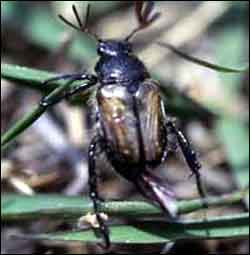Sex Pheromone Blocked in Bug

Male scarab beetles use their antennae to follow a female’s scent. (Walter Leal/UC Davis photo)
Science can put a dent in the sex life of a scarab beetle by blocking its ability to pick up female scent, according to Walter Leal, professor of entomology at UC Davis. The research could eventually lead to methods to control insect pests without affecting harmless or beneficial insects.
“Chemical communication is the prime means of communication in insects,” Leal said. If those communications can be controlled in the environment, insect pests could be prevented from breeding, he said.
Female pale-brown chaffers, a scarab beetle that is an agricultural pest in Japan, release a chemical signal or pheromone to attract males.
Insects smell through their antennae. Inside the antennae, pheromone molecules hit a specific switch that sends a nerve signal to the insect’s brain. Before the switch can fire again, it must be reset by removing the pheromone, like a wine-taster rinsing her palate.
As they fly toward the female, the male beetles come across wafts of pheromone separated by periods of no scent. To get an accurate reading and stay on course, the beetle must constantly reset its pheromone detection system.
Leal worked with Martine Maibeche-Coisne and Emmanuelle Jacquin-Joly at the Institut National de la Recherche Agronomique in Paris, France; Alexander Nikonov at the National Institute of Agrobiological Sciences in Tsukuba, Japan; and Yuko Ishida at UC Davis. They identified an enzyme called CYP4AW1, expressed in the antennae, that breaks down the pheromone.
When beetles were exposed to both pheromone and metyrapone, a chemical that specifically blocks the enzyme, they could smell the pheromone at first but then could not reset their antennae. They were unable to smell new doses pheromone for several minutes.
The treatment had no effect on other insects, because the enzyme is very specific to that pheromone, Leal said.
The same principles could be applied to agricultural pests and to disease-carrying mosquitoes, he said. For example, female mosquitoes find hosts by smell and use pheromones to guide other females to good egg-laying sites.
The work was published July 26 in the Proceedings of the National Academy of Sciences of the USA online.
Media Contact
More Information:
http://www.ucdavis.eduAll latest news from the category: Life Sciences and Chemistry
Articles and reports from the Life Sciences and chemistry area deal with applied and basic research into modern biology, chemistry and human medicine.
Valuable information can be found on a range of life sciences fields including bacteriology, biochemistry, bionics, bioinformatics, biophysics, biotechnology, genetics, geobotany, human biology, marine biology, microbiology, molecular biology, cellular biology, zoology, bioinorganic chemistry, microchemistry and environmental chemistry.
Newest articles

Physicists arrange atoms in extremely close proximity
The technique opens possibilities for exploring exotic states of matter and building new quantum materials. Proximity is key for many quantum phenomena, as interactions between atoms are stronger when the…

For microscopic organisms, ocean currents act as ‘expressway’ to deeper depths
New research shows how tiny plant-like organisms hitch a ride on ocean currents to reach darker and deeper depths, where they impact carbon cycling and microbial dynamics in the subtropical…

FDmiX: Fast, robust series production of nanoparticles
Nucleic acid-based medications such as mRNA vaccines are opening up new therapeutic approaches. These active ingredients must be enclosed inside nanoparticles to ensure that they get to where they are…





















